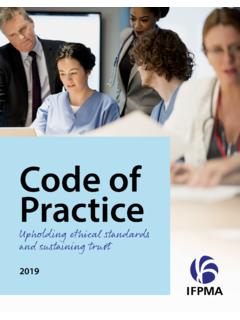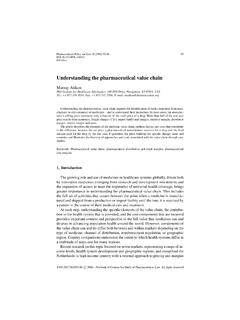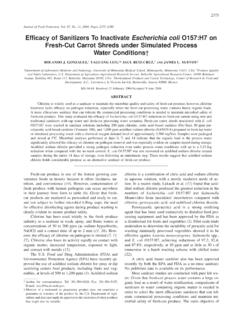Transcription of Introduction to Biosimilars & Regulatory Requirements
1 3fact shee t 3 Introduction to Biosimilars & Regulatory RequirementsInternational Federation of Pharmaceutical Manufacturers & AssociationsChemin des Mines BOX 1951211 Geneva 20 SwitzerlandInternational Alliance of Patients OrganizationsCAN Mezzanine49-51 East Road LondonN1 6 AHUnited Medicines Agency. Guideline on similar biological medicinal products containing biotechnology-derived proteins as active substance: non-clinical and clinical issues. In: (CHMP) ECfMPfHU, ed. London, United Kingdom, World Health Organization, INN Working Doc. , Proposal for Assignment of Biological Qualifi ers (BQ), 2015 Rak Tkaczuk KH, Jacobs IA.
2 Biosimilars in Oncology: From Development to Clinical in Oncology 2014;41, Supplement 3:S3-S12. doi: chemically synthesized drugs are small molecules. Generic copies are considered to be identical to the originals; they have the same active ingredients and work exactly the same way. Biologics are large complex compounds made from living organisms. A biosimilar is a highly similar but not identical version of the original (also known as reference ) biologic. While there are inherent variations from batch to batch of a biologic, these differences are minor and tightly controlled by the manufacturing process within a certain range so quality is not affected.
3 This is not the same as differences between the original biologic and biosimilar. Because the cell cultures (starting material) and production steps are the exclusive knowledge of the originator, it is not possible for a biosimilar company to precisely replicate the original manufacturing & Regulatory REQUIREMENTS03 BiosimilarsIntroduction to Biosimilars are designed to be highly similar to their reference & Regulatory REQUIREMENTS04A generic drug is, by defi nition, an identical copy of its reference small-molecule are not genericsUnlike generic medicines, Biosimilars will not be identical to their reference synthesis; derived from living systems, using recombinant DNA injectedSizeStructureProductionAdministr ationSmallSimple and well defi nedProduced through standard chemical can be swallowedTable CLINICAL STUDY: MAIN FEATURESF igure diagram illustrates some of the studies that Biosimilars undergo before approval.
4 For this process to be successful no clinically meaningful differences can be of subjectsRandomization/Double-blindedOrig inator medicine (reference)Proposed biosimilar medicine (test)No clinically meaningful differences demonstratedPK,PD safety assessment in a small group of subjectsPK,PD safety assessment in a small group of subjectsPhase 1 Phase 2 Effi cacy, safety & immunogenicity assessment in a larger group of patientsEffi cacy, safety & immunogenicity assessment in a larger group of patientsNo clinically meaningful differences demonstratedBIOSIMILARS & Regulatory REQUIREMENTS09 The main principles are as follow:Clinical evaluation: Approval of Biosimilars is based on clinical evidence, ideally from comparative Clinical Study trials with target patients, demonstrating a highly similar level of clinical benefi t and safety compared to their reference biologics.
5 Generics do not require clinical trial evidence, as they are considered identical to their reference testing: Specifi c testing is needed in patients during the development of Biosimilars to ensure that they do not cause any severe immune reactions. This level of testing is not required from generics as they are not produced from living organisms, and unlikely to elicit immune : Individual patients must be closely monitored to identify desired benefi cial outcomes as well as adverse effects. Additionally, there should be systems to record and analyse collected information to capture how Biosimilars are working in all types of patients in real-world of Biosimilars : Ideally, each biosimilar should be clearly identifi ed with a unique brand name, international non-proprietary name (INN), and batch number.
6 This allows patients and health professionals to clearly know exactly which medicine they are receiving and will be increasingly important as more than one biosimilar is developed to the same reference biologic. By contrast, generics generally do not have unique brand names and share the same INN as their reference. To avoid proliferation of separate and distinct national qualifi er systems, the WHO INN Expert Group proposed a scheme in which a unique identifi cation code named a Biological Qualifi er (BQ) is assigned to all biological substances having (or eligible to have) INNs. The BQ is an additional and independent element used in conjunction with the INN to uniquely identify a biological substance to aid in the prescription and dispensing of medicines, pharmacovigilance and the global transfer of prescriptions.
7 3 Biosimilars & Regulatory REQUIREMENTS08 REGULATION OF BIOSIMILARSB iologics are sensitive to variations in the manufacturing process and the starting materials; therefore, a biosimilar will never be an exact copy of the reference biologic, as explained earlier. To be approved as a biosimilar, products must demonstrate high similarity to the reference biologic in manufacturing quality, biologic activity, clinical safety and effi cacy, and in the rate of immune reactions. Specifi c clinical studies are required to demonstrate this European Medicines Agency (EMA) developed the fi rst biosimilar guidelines in 2 In 2009, WHO developed a set of global (non-country specifi c) guidelines for similar biotherapeutic products (SBPs) (more commonly known as Biosimilars ) to assist and ensure local Regulatory authorities adhere to international standards.
8 WHO guidelines set out basic principles considered mandatory to assure safety , effi cacy, and quality of Biosimilars . A synopsis of these principles follows (a more extensive overview on these principles can be found in Fact Sheet 8).Reference product: The reference product (RBP) is the originator products, which should be licensed based on full quality, safety , and effi cacy data and should be authorized in the country or region in question. Wherever it may not be feasible, such as countries lacking nationally licensed RBPs, additional criteria (such as the product should be licensed and widely marketed in another jurisdiction with robust Regulatory review processes) may be : All aspects of quality and heterogeneity should be assessed, including comparative studies with the reference product (most often the commercial product).
9 Where possible, the product should be tested with and without data: Data should include pharmacodynamics (PD), pharmacokinetic (PK), and comparative repeat-dose toxicity studies in a relevant species. The PK of the biosimilar and RBP are compared in terms of absorption, bioavailability, and elimination characteristics. Clinically relevant PD markers should be selected and may be investigated in the context of combined PK/PD studies: Similarity of the effi cacy of the biosimilar and the RBP will usually have to be demonstrated in adequately powered, randomized, and controlled clinical trial(s). Immunogenicity should always be investigated in humans before authorization.
10 Effi cacy trials with Biosimilars are not designed to determine whether the medicine works but whether there are any clinically meaningful differences between the biosimilar and the : Drug safety monitoring or a pharmacovigilance plan, at the post-marketing phase is included in the guideline to supplement the limited clinical data that is present during marketing authorization. In some cases an associated risk management plan is & Regulatory REQUIREMENTS05 While the defi nition of biosimilar and specifi c Regulatory pathway varies across jurisdictions, most well established Regulatory authorities (EMA, Health Canada, US FDA, Japan, Korea) incorporate these principles.















